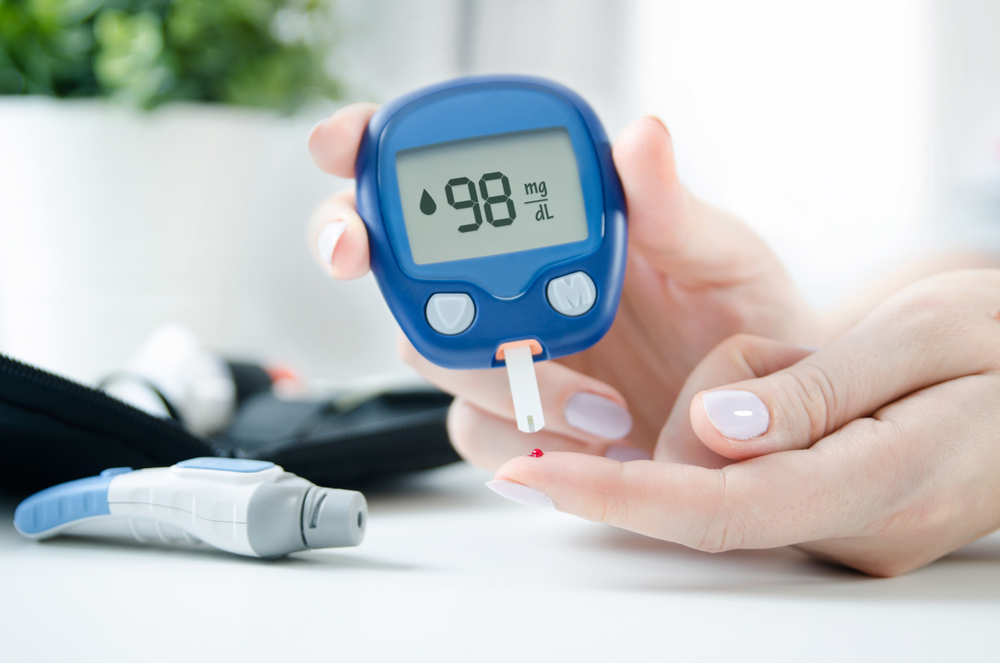Hyperglycemia, which is another name for high blood sugar, has been linked to both diabetes and its precursor, prediabetes. Prediabetes is defined as having a high blood sugar level, but not enough to qualify as diabetes. Insulin, a hormone that helps your cells metabolize the sugar contained in your bloodstream, is often responsible for regulating your blood sugar levels. As a result, insulin is a critical player in the balance of blood sugar.
But there are a number of things that might compromise blood sugar control and result in hyperglycemia. Internal reasons for high blood sugar include excessive glucose production by the liver, insufficient insulin production by the body, or inadequate insulin use by the body. Insulin resistance is the term for the latter.
A sedentary lifestyle, certain drugs, poor food, and stress are examples of external causes. It is estimated that 13% of people in the United States are diabetic, with an additional 34.5 percent of the population having prediabetes. This means that over half of the adult population in the United States is either diabetic or at risk of developing the disease.
Balancing blood sugar is critical for diabetics since uncontrolled blood sugar can even pave the way for amputations and other life-threatening consequences.
Take a look at these 14 simple and scientifically proven methods to balance blood sugar levels naturally.
Table of Contents
1. Get regular exercise

A healthy weight and improved insulin sensitivity can be achieved and maintained by regular exercise. An increase in insulin sensitivity implies that your cells are better equipped to use the sugar that is now present in your circulation. Exercise also aids in the use of blood sugar by your muscles for the generation of energy and the contraction of muscles.
Keep track of your blood sugar levels before and after exercise if you have trouble controlling your levels. Keeping your blood sugar levels in check can help you better understand how your body responds to various activities. In addition, experts advised undertaking so-called “exercise snacks” to reduce blood sugar and minimize the damage that comes with being seated at a desk all day long.
The term “exercise snack” simply refers to taking a little break from your sitting every 30 minutes or so during the day to perform some sort of physical activity. Squats and leg lifts, as well as mild walking, are among the encouraged workouts.
Weightlifting, brisk walking, hiking, swimming, jogging, bicycling, dancing, and more are all good types of exercise. Regardless of the intensity, any exercise that keeps you moving on a daily basis is better than a sedentary existence.
Also, keep in mind that even if you find it difficult to set aside time for regular exercise on a weekly basis, you may still get the advantages of even shorter workouts. For example, aim for three 10-minute workouts a day, 5 days a week for a total of 150 minutes of weekly activity.
2. Keep an eye on carb intake
Carbohydrate consumption has a significant impact on balancing blood sugar levels. When carbohydrates are consumed, they are digested by the body and converted into glucose. Insulin then aids in the use and storage of this glucose for later usage as a source of energy.
This mechanism can malfunction if you consume too many carbohydrates or have insulin-function issues, causing your blood glucose levels to increase. The ADA suggests that diabetics keep track of their carb consumption by keeping track of how many carbohydrates they consume and being aware of how much they require.
This may help you plan your meals better, which might lead to better control of your blood sugar levels, according to some research. Low-carbohydrate diets have been shown to balance blood sugar levels, as well as to decrease and avoid blood sugar spikes. To be clear, a low-carb diet is not the same as a no-carb diet.
If you're watching your blood sugar, it's okay to eat a few carbohydrates. It's better to consume more whole grains and less processed and refined carbohydrates since they give more nourishment and help lower blood sugar levels.
3. Ramp up fiber consumption
While there are a lot of supplements to lower blood sugar naturally, fiber does a great job at doing this as well. Fiber promotes a slower increase in blood sugar levels by slowing carbohydrate breakdown and sugar absorption. Insoluble and soluble fibers are both forms of fiber. However, soluble fiber has been specifically demonstrated to benefit the control of blood sugar, but insoluble fiber has not.
The capacity of your body to control blood sugar and prevent low blood sugar levels can be improved by eating a diet high in fiber. If you have type 1 diabetes, this might be a lifesaver. Among the many high-fiber foods are:
- Veggies
- Fruits
- Legumes
- Unprocessed foods
Women should consume around 25 grams of fiber per day, while males should consume about 35 grams per day. That works out to around 14 grams per 1,000 calories.
4. Drink lots of water and stay hydrated

You may be able to balance blood sugar levels by drinking plenty of water. In addition to keeping you hydrated, it aids in the removal of excess sugar from your system via the kidneys.
According to one study, people who consumed more water displayed a lowered risk of developing hyperglycemia. Adequate fluids may help rehydrate the body, decrease blood sugar, and lessen the chance of developing diabetes.
Water and other calorie-free beverages should always be preferred. Sugar-sweetened items should be avoided since they can elevate blood glucose levels, lead to weight gain, and raise the chance of developing diabetes.
5. Try portion control
Maintaining a healthy weight is possible with the use of portion management. A lower chance of acquiring type 2 diabetes is associated with a reduction in body mass index (BMI). To avoid blood sugar spikes, keep track of your portion amount.
Here are a few strategies to help you control portion sizes:
- Take the time to weigh and measure your food servings.
- Reduce the plate size.
- Don't eat at all-you-can eateries
- Check the serving amounts on the food labels
- Jot down your food intake in a notebook
- Savor each mouthful
6. Opt for low glycemic index foods
In terms of how quickly carbohydrates are digested and absorbed, the glycemic index (GI) is used. This has an effect on how rapidly your blood sugar levels rise. Low, medium, and high glycemic index foods are ranked from 0 to 100. Foods with a GI score of 55 or below are considered low GI.
Both the number and kind of carbohydrates you consume have an impact on your blood sugar. Low-GI diets have been demonstrated to help diabetics lower their blood sugar levels.
Low-to-moderate GI foods include, for example:
- Greek yogurt with no added sugar
- Oats
- Beans
- Bulgur
- Barley
- Lentils
- Legumes
- Pasta made with whole grain
- Veggies that don't have any carbohydrates
Additionally, the addition of protein or healthy fats reduces blood sugar spikes following a meal.
7. Give stress management a try
Your blood sugar levels might be linked to stress. It is known that stress raises blood sugar levels by secreting glucagon and cortisol chemicals.
Exercise, relaxation, and meditation were found to reduce stress and lower blood sugar levels in research involving a class of students. People with chronic diabetes who are having difficulty with insulin secretion may benefit from practices such as yoga and mindfulness-based stress reduction.
8. Monitor your blood sugar levels
Keeping an eye on your blood glucose levels might make it easier to keep it under control. You should use a glucometer to check your blood sugar levels at home. You can talk to your doctor about this option.
Keeping track helps you assess whether or not you need to change your diet or drug regimen. It also teaches you about the reactions your body has to different diets.
Keeping a journal of your levels is a good way to keep track of your progress. As a further tip, you might want to monitor your blood sugar levels in pairs, such as before and after an activity or two hours before and after eating anything.
A blood sugar test might help determine whether you need to make minor adjustments to a meal if it raises your blood sugar. In some cases, a starchy side can be swapped for non-starchy vegetables or limited to a few.
9. Aim for adequate quality sleep

Adequate sleep not only makes you feel great, but it is also essential to your health and can help you balance blood sugar.
Type 2 diabetes can be exacerbated by sleep deprivation, which raises blood sugar levels and impairs insulin sensitivity. Moreover, they can lead to a greater appetite for food, which can lead to weight gain. Cortisol, a hormone that regulates blood sugar, is also elevated when people don't get enough shut-eye.
The quality and amount of sleep are intertwined. Adults should sleep for a minimum of 7–8 hours per night, according to the National Sleep Foundation.
Try these tips to get a better night's sleep:
- Adhere to a sleep routine
- Stay away from late-day caffeine and alcohol consumption
- Engage in frequent physical activity
- Reduce screen time before going to bed.
- A cool bedroom is a must.
- Limit the number of naps you take.
- Set up a sleep routine that works for you.
- Combine lavender and other relaxing smells to help you relax
- Don't work in your bed.
- Before you go to bed, take a shower or enjoy a warm bath
- Try meditating or using guided imagery as a form of relaxation.
10. Eat chromium and magnesium rich foods
Micro-nutrient deficiencies have been related to high blood sugar levels and diabetes. Chromium and magnesium deficiency are only two instances of this type of imbalance.
Carbohydrate and lipid metabolism is also affected by chromium. It may enhance insulin's ability to regulate blood sugar levels.
The following foods are high in chromium:
- Meats
- Wheat and grain-based foods
- Fruit
- Veggies
- Nuts
However, the mechanics behind this suggested link are not completely understood, and investigations have yielded varied results. As a result, additional study is required.
Blood sugar levels respond well to magnesium supplementation as well. Magnesium-rich diets, on the other hand, have been linked to a lower incidence of diabetes and can help balance blood sugar levels.
People with diabetes who have low magnesium levels are more likely to develop insulin resistance and a reduced ability to tolerate glucose.
It is possible that taking magnesium supplements may not be necessary if you are currently eating a diet high in magnesium-rich foods and have acceptable blood magnesium levels.
Foods high in magnesium include:
- Greens with a deep, rich color
- Seed mixtures from squash and pumpkins
- Tuna
- Raw, unprocessed grains
- Chocolate with a deep, rich flavor
- Bananas
- Avocados
- Beans
11. Incorporate specific foods to your diet
The therapeutic effects of a wide variety of foods and plants have been documented. There is, however, a lack of high-quality data for these components due to the small sample sizes or insufficient human trials. As a result, it is impossible to provide definitive recommendations on their usage.
Included in this list of “anti-diabetes” foods are:
Apple cider vinegar
By preventing your stomach from emptying completely after a meal, this substance has been shown to balance blood sugar levels.
Cinnamon
By improving insulin sensitivity and decreasing the digestion of carbohydrates in the digestive system, this spice may balance blood sugar levels. As a result, the spike in blood sugar that follows a meal is reduced. Nonetheless, further investigation is required.
Berberine
There is evidence to suggest that this chemical decreases blood sugar levels via boosting insulin secretion and encouraging the metabolization of glucose by enzymes.
Seeds of the fenugreek plant.
There is some evidence to suggest that fenugreek may assist in the control of blood sugar levels; nevertheless, further high-quality research on people is required.
If you're currently on blood sugar-lowering drugs, it's imperative that you consult your doctor before including any of these items into your diet. Some herbal supplements may interact poorly with these medications.
Finally, dietary supplements are not subject to FDA regulation in the same way that prescription drugs are. As a result, it's critical to only buy supplements that have been thoroughly examined by a third-party laboratory to ensure their purity and composition.
12. Maintain a healthy weight
Diabetes can be averted if you maintain a healthy weight and eat a healthy diet. Just 5 percent weight loss can help regulate your blood sugar levels and lessen the need for diabetic medication, according to studies.
Blood sugar levels may improve significantly if someone who weighs 200 pounds (91 kg) drops merely 10-14 lbs (4.5–6 kg).
In addition, if you lose more than 5% of your original weight, you may see an improvement in your HbA1c results. Blood sugar levels during the previous three months can be gauged using this method.
13. Frequently munch on healthy snacks

Avoiding both high and low blood sugar levels by eating often throughout the day may help you maintain a healthy weight. In addition to reducing your chance of developing type 2 diabetes, snacking between meals may also help you stay healthy.
Studies have shown that eating smaller, more frequent meals throughout the day can enhance insulin sensitivity and reduce blood sugar levels.
It is also possible to reduce HbA1c (glycated hemoglobin) results by having smaller meals and nutritious snacks over the course of the day.
14. Eat probiotic-rich foods
In addition to improving blood sugar control, probiotics provide various other health advantages.
Type 2 diabetics may benefit from consuming probiotics since they reduce fasting blood sugar, glycated hemoglobin (HbA1c), and insulin resistance.
It's interesting to note that studies have shown that persons who drink different species of probiotics and do so for at least eight weeks see greater improvements in blood sugar levels.
Foods that are rich in probiotics can be found in fermented meals such as:
- Yogurt, as long as the label specifies that it includes live and active cultures
- Kefir
- Sauerkraut
- Kimchi
- Tempeh
Summing It Up
You have the option to balance blood sugar levels in a variety of methods that are entirely natural.
In many cases, this means altering your daily routine to incorporate things like eating healthier, using supplements to lower blood sugar naturally, exercising, and drinking more water. However, the most significant changes will come from your food choices.
Before making any lifestyle or supplement changes, especially if you’ve been diagnosed with blood sugar control issues or are using medicines, consult with your healthcare provider.
